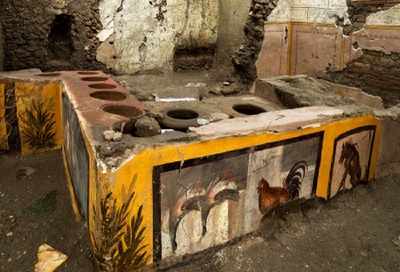[ad_1]

SNAIL, FISH AND SHEEP SOUP, ANYONE? Archaeologists in Pompeii, the city buried in a volcanic eruption in 79 AD, have discovered a frescoed hot food shop that served up the ancient equivalent of street food to Roman passersby. The contents of the jars found at a ‘thermopolium’, Latin for snack bar, included a soupy concoction of snails, sheep and fish (AFP photo)
ROME: Wine turned white with crushed fava beans. A soupy concoction of snails, sheep and fish. If these do not sound particularly appetizing today, they appear to have been all the rage in ancient Pompeii, as evidenced by ancient leftovers found during excavations this month at the archaeological site of the former Roman city. They were found in a thermopolium — or snack bar — serving street food popular in 79 AD.
Two years after it was first partly unearthed, archaeologists began to excavate the interior of the shop this October. In December, they found food and drink residue that is expected to provide fresh clues about the ancient population’s culinary tastes. The work offers “another insight into daily life at Pompeii” and represents the “first time an area of this type has been excavated in its entirety”, Massimo Osanna, the departing director of the Archaeological Park of Pompeii, said Saturday.
Human life in Pompeii came to an abrupt halt nearly 2,000 years ago, when Mount Vesuvius spilled tons of lapilli, ash and rock onto the ancient Roman city, preserving it in time. Over the centuries, Pompeii became a powerful symbol of the transience of life. Since excavations began in 1748, fragments of that ancient civilization have continued to emerge. About 80 thermopolii have been found at Pompeii, where residents could choose their edibles from containers set into street-front counters.
The one excavated this month included a large dolium, or earthenware vessel, that had contained wine. The contents of two other jars remain to be analyzed, but Chiara Corbino, the archaeozoologist involved in the dig, said it appeared that they contained two kinds of dishes: a pork and fish combination found “in other contexts at Pompeii”, and a concoction involving snails, fish and sheep, perhaps a soup or stew. “We will analyze the contents to determine the ingredients and better understand what kind of dish it was,” she said. For now, she thinks the thermopolium probably served a stew or soup that included “all these animals together.”
Two years after it was first partly unearthed, archaeologists began to excavate the interior of the shop this October. In December, they found food and drink residue that is expected to provide fresh clues about the ancient population’s culinary tastes. The work offers “another insight into daily life at Pompeii” and represents the “first time an area of this type has been excavated in its entirety”, Massimo Osanna, the departing director of the Archaeological Park of Pompeii, said Saturday.
Human life in Pompeii came to an abrupt halt nearly 2,000 years ago, when Mount Vesuvius spilled tons of lapilli, ash and rock onto the ancient Roman city, preserving it in time. Over the centuries, Pompeii became a powerful symbol of the transience of life. Since excavations began in 1748, fragments of that ancient civilization have continued to emerge. About 80 thermopolii have been found at Pompeii, where residents could choose their edibles from containers set into street-front counters.
The one excavated this month included a large dolium, or earthenware vessel, that had contained wine. The contents of two other jars remain to be analyzed, but Chiara Corbino, the archaeozoologist involved in the dig, said it appeared that they contained two kinds of dishes: a pork and fish combination found “in other contexts at Pompeii”, and a concoction involving snails, fish and sheep, perhaps a soup or stew. “We will analyze the contents to determine the ingredients and better understand what kind of dish it was,” she said. For now, she thinks the thermopolium probably served a stew or soup that included “all these animals together.”
[ad_2]
Source link